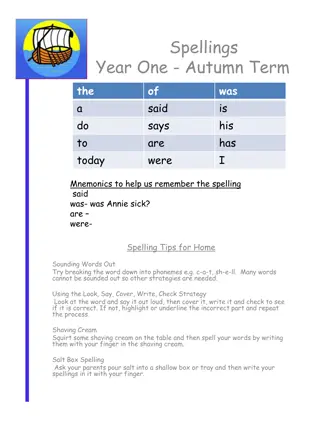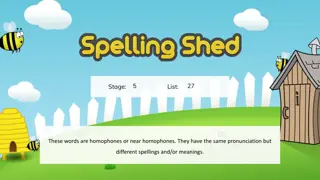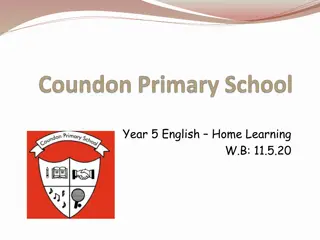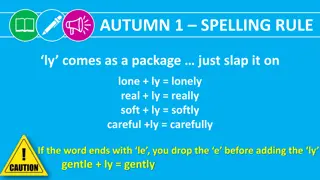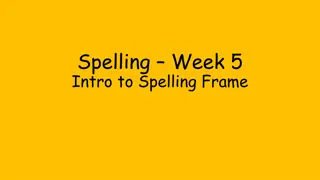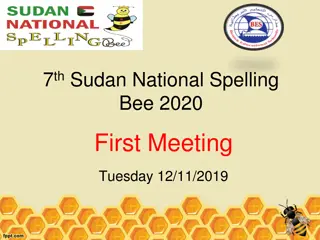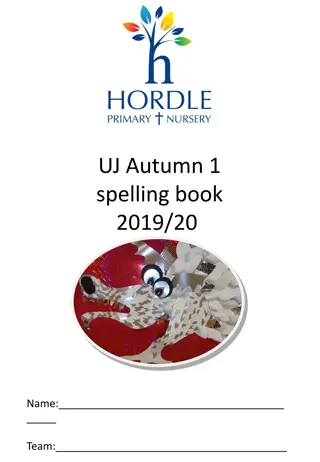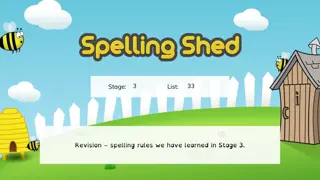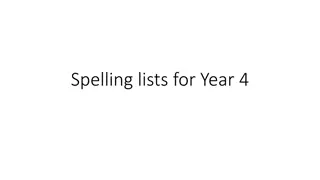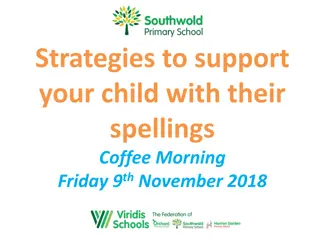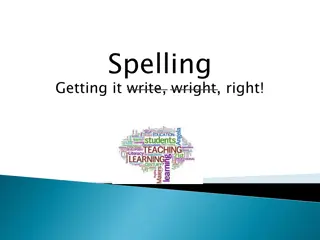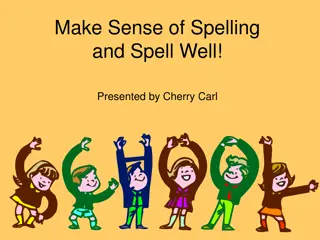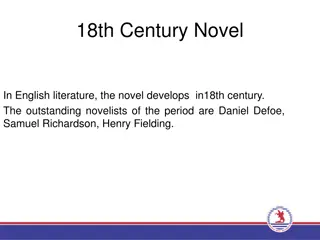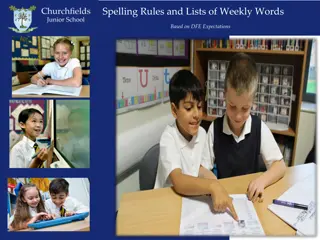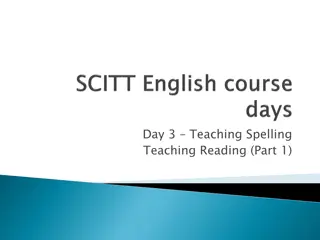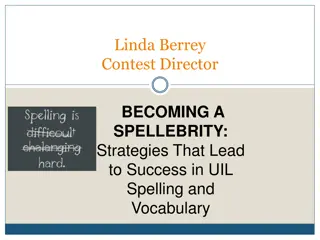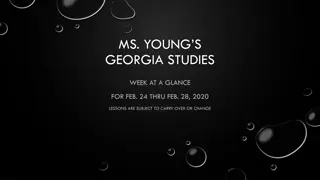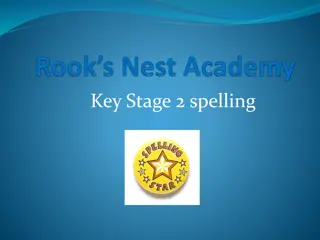
Innovative Approach to Spelling Strategies Revealed
Explore the effective teaching methods of Wraparound Spelling program, sharing student results, theories, and practices. Discover the benefits and pupil feedback while gaining insights into spellings challenges and solutions. Dive into sound variations and letter sounds to enhance spelling skills.
Download Presentation

Please find below an Image/Link to download the presentation.
The content on the website is provided AS IS for your information and personal use only. It may not be sold, licensed, or shared on other websites without obtaining consent from the author. If you encounter any issues during the download, it is possible that the publisher has removed the file from their server.
You are allowed to download the files provided on this website for personal or commercial use, subject to the condition that they are used lawfully. All files are the property of their respective owners.
The content on the website is provided AS IS for your information and personal use only. It may not be sold, licensed, or shared on other websites without obtaining consent from the author.
E N D
Presentation Transcript
Wraparound Spelling Tuesday 18th February 2020 How we teach our spehling speling spelling
Aims Share the spelling results from August 2019 to January 2020 The theory and practice of Wraparound Spelling How we deliver the programme The benefits of the new programme Pupil Voice What do the pupils think? What do we do now? What you can do to help your child Any questions and feedback
P3-7 Spelling Age Median Comparison 14 0:00 12 +1:01 10 +0:06 +1:00 +1:02 8 10 years 7 months + 12 years 9 years 7 months + 12 years 9 years 6 month 9 years 1 month 8 years 6 months 7 years 6 months 7 years 5 months 6 6 years 3 months 4 2 0 P4 P5 P6 P7 P3 January August
P7 Spelling Age Comparison 60 50 40 30 46 53 20 10 15 11 10 7 0 Same as actual age or above 1-11 months below actual age 12 months or more below actual age January August
The Theory and Practice of Wraparound While we use our eyes to read, the starting point for spelling is sound. What a child must do to become a reader (and speller) is to figure out how the words s/he hears and knows how to say, connect to letters on the page. Writing is a code humans invented to represent speech sounds. Children have to crack that code to become readers and spellers. Children should not see a word before trying to spell it. They will hear it, split it into how many sounds there are and attempt to spell it by stretching it. e.g. catch = c-a-t-ch (4 sounds) begging = b-e-gg-i-ng (5 sounds)
Can you tell me different ways to make the sound s? The SOUND s can be made in a number of ways: s = sun ss = glass Soft c: ci = circle ce = palace cy = cycle sc = scissors st = castle se = house Is it any wonder that spelling is hard?
Crown Time Dialect and accent have a great place in life. In spelling they can cause problems. In spelling, if we don t pronounce words accurately, then it can be difficult to sound out how a word is constructed. So In crown time we speak the Queen s English. We must repeat and model good pronunciation when we hear words spoken incorrectly.
Technical Terms The sounds used in speech. How the sounds of words are represented in writing. Two sounds which together make one sound. These cannot be sounded out individually. ch ai n s aw Phoneme Grapheme Digraph Three sounds which together make one sound. b r igh t Trigraph Sounds which are split by another letter but together make one sound. Below, the A sound is made by the a and e, but split by the p. Sometimes called magic e sh a p e Split digraph
Introducing Our Special Friends Many of our words have special friends! Close friends chicken, lightning (digraphs and trigraphs) Distant friends tape, grape (split digraphs) Some have both - chocolate We use the terms above to make it more child friendly .
Wraparound Spelling - Monday Use new spelling list for the week. Say the first word (do not write it yet) and ask the children to count the number of sounds in the word. Reading goes from concrete written word to abstract thought and sound. Spelling goes from abstract thought and sound and as it is written it takes on its concrete form. C-a-t (3 sounds) Ch-a-t (3 sounds)
Talk about how you write each sound as you write the word on the board. Refer to the sound chart for alternative ways of writing a sound. If a sound is made up of more than one letter, these are referred to as special friends. i.e. special friends = oo; ee; ch; igh
Stretch with Special Friends Ask the children to identify the special friends and underline them. Model sounding out the word (stretch) and then saying it. c a t = cat Ask the children to repeat it. Ask the children to attempt to write the word. Once they have done this, you write it on the board and ask them to tick each correct sound. ch a t = chat
Grow the Word: Roots and Shoots Focus word: watch (root) Growing and shrinking words: watches, watching, watchers, stopwatch, wristwatch etc. Focus word: photograph Growing and shrinking words: photographs, photo (prefix), photographer, photogenic
Why grow the words? It adds to a child s use of vocabulary. It shows regular changes: tenses, plurals, verb endings, affixes (morphological awareness) This maintains learning and puts it into long term memory. All children in the class start with the same word. Growing the words allows for differentiation and challenge. This approach enables EVERY CHILD to experience success. Those who find spelling hard can stick with the shorter root word. A child who finds the root word too easy uses a word that was grown.
Spiral Phonics Doing this means that we are creating an upward spiral of provision so some pupils during the lesson will revise, focus on the lesson and setting the scene for further learning.
The word in context Ask the children to put the word into a sentence to show what the word means. Word: watch Pupil: I have a watch. Teacher: I have a watch. Why? Pupil: I have a watch so that I can tell the time. Teacher: I have a watch so that I can tell the time. Teacher: How many words are in the sentence? Pupils: 11
Sentence Structure Give children the opportunity to hear and rehearse good sentence structure. Encouraging them to rehearse good sentence structure helps them to write more accurately and not write a stream of consciousness which is often not purposeful or coherent. If they count the number of words before they write, they can check that none are missing.
A sentence a day (dictation) Use one of the sentences and practice each day. E.g. The kitchen was wet. (Why?) The kitchen was wet because I left the tap running. Say the sentence several times. (10 words) Ask the children to count the number of words in the sentence. Ask children to write it down. Then you write it and ask them to check it. They should tick capital letters and punctuation too. The kitchen was wet because I left the tap running.
Syllables (Tuesday) If some of the words have more than one syllable, circle the vowel sounds and clap out the syllables. Draw a dividing line to show syllable divisions. This is an important strategy for spelling longer words. Each syllable must contain a vowel sound. unhappily
Rhymes (Tuesday) Ask pupils to look for words which rhyme with the focus word. Accept nonsense words as well as real words but make sure the pupils know the difference. This is a useful strategy for reducing the amount of encoding needed in a word if they know how the rhyme in the rhyming word is written. Take the opportunity (if it arises) to show that some rhymes have different phonic patterns. e.g. eight and plate
Parts of Speech (Wednesday) Look at some of the words in the spelling list and show the pupils how to identify the parts of speech. The parts of speech you concentrate on will depend on the stage of your pupils. First Level: nouns, proper nouns, verbs, adverbs, adjectives Second Level: +, conjunctions, prepositions, uncountable nouns, collective nouns, contractions, proper adjectives, abstract nouns, articles
Parts of Speech (Wednesday) Show pupils how when we change the part of speech, the spelling often is altered. Noun Respect Respect should be shown to your parents. Invitation He gave me an invitation to the party. Verb Respect I respect my teachers. Adjective Respectful He walked at a respectful distance. Adverb Respectfully He spoke respectfully. Invite Inviting It was such an inviting room. Invitingly She smiled invitingly at the children. I want to invite you to my party.
Cues (Wednesday) If there are words that the pupils are finding difficult, then work with them to find a cue to aid memorising it. i.e. necessary one collar - two sleeves It is necessary to have one collar and two sleeves on a shirt.
Cues Cont. (Wednesday) Because Big Elephants Can Always Understand Small Elephants Could/Would Oh U Lucky Duck
Roots and shoots (Thursday) This is revising some of the work done on Monday but in more explicit detail by growing and shrinking words by looking for the root word and adding or taking away prefixes and suffixes. Talk about how the prefixes and suffixes change the meaning of the root word and sometimes the spelling.
Roots and shoots (Thursday) international national countries inter international Involving two or more countries Between, jointly
Games, Assess and Rectify (Friday) The focus is on the original word however during the quiz time, the pupils can write any shoot or root words. They may be given a final score of 10/10 +9 Children are given the base word. e.g. spell pet All children spell pet. For those who find this easy, it takes a matter of seconds. They then spend the remaining time challenging themselves on their shoot words. For those who find pet difficult, they are involved to the same level as all of their peers. The positive impact this has on their self esteem will be substantial. They are also then encouraged to try to go beyond this. There is no ceiling automatically placed on them. An opportunity should be given to correct any mistakes.
Pupil Voice We asked the pupils if they enjoyed the new programme and if they thought it had helped them to improve.
Do you enjoy the new spelling programme? The same as before Yes No
Do you think the new spelling programme has helped you with your spelling? The same as before Yes No
I enjoy it because it is challenging to get the roots and shoots for each word. I like how we get to stretch the words and sound them out before we write them.
I like learning about the different parts of speech - adverbs, verbs ,nouns and adjectives. It makes me more aware of words I choose to put in a sentence. I like making up dictation sentences instead of just writing the words out.
Syllables help with not just spelling but also pronunciation. Looking at spelling in more than one way is a positive. Helps you think of more words using roots and shoots. I like that we all have the same words and no more groups. It takes longer to do in class. It helps my reading.
How useful is looking at words that rhyme? When you rhyme it encourages us to look at different spellings for the same sound. I like having rhyming competitions to see who can get the most.
It takes longer to do in class. It takes longer to do. It has helped because we have done more work on it every day.
I like how we It takes longer to do in class. I am more confident. It takes longer to do in class. use special friends. I am learning things I never knew before. It is fun!
What next for the school? In January we used the spelling test results to decide who would continue with the same spelling words and who would move to their own spelling sounds. We will continue to embed the Wraparound Spelling programme and routines for all stages and individuals. We will continue to monitor and record the progress of all pupils.
Thank you. Please complete the feedback by visiting https://bit.ly/366ArU2 take a paper copy or use the link on the School Blog.

